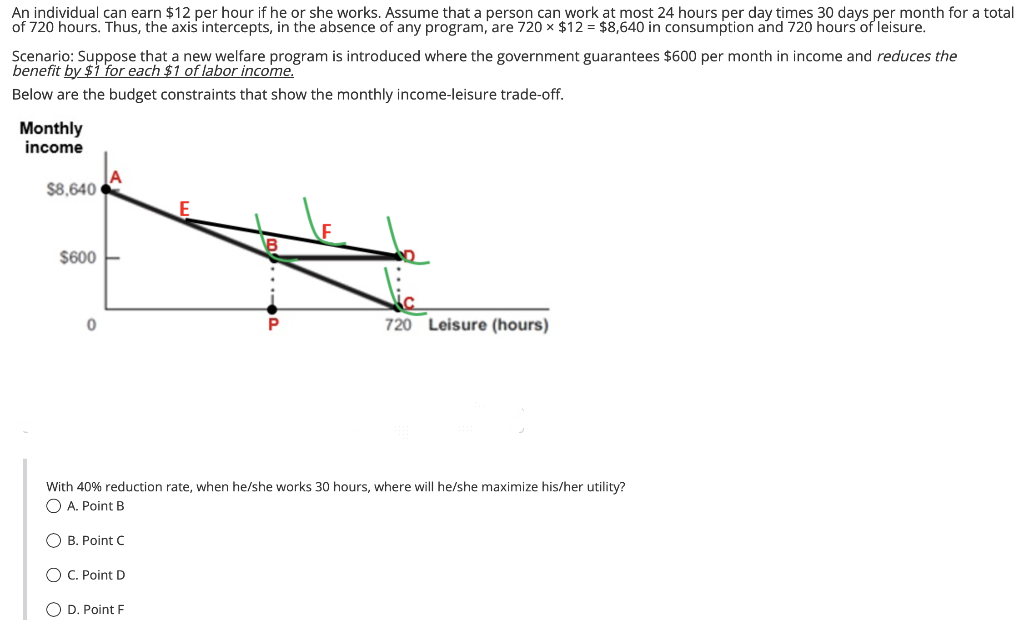An individual can earn $12 per hour if he or she works. Assume that a person can work at most 24 hours per day times 30 days per month for a total of 720 hours. Thus, the axis intercepts, in the absence of any program, are 720 × $12 = $8,640 in consumption and 720 hours of leisure. Scenario: Suppose that a new welfare program is introduced where the government guarantees $600 per month in income and reduces the benefit by $1 for each $1 of labor income. Below are the budget constraints that show the monthly income-leisure trade-off. Monthly income $8,640 $600 720 Leisure (hours) With 40% reduction rate, when he/she works 30 hours, where will he/she maximize his/her utility? O A. Point B O B. Point C O C. Point D O D. Point F
An individual can earn $12 per hour if he or she works. Assume that a person can work at most 24 hours per day times 30 days per month for a total of 720 hours. Thus, the axis intercepts, in the absence of any program, are 720 × $12 = $8,640 in consumption and 720 hours of leisure. Scenario: Suppose that a new welfare program is introduced where the government guarantees $600 per month in income and reduces the benefit by $1 for each $1 of labor income. Below are the budget constraints that show the monthly income-leisure trade-off. Monthly income $8,640 $600 720 Leisure (hours) With 40% reduction rate, when he/she works 30 hours, where will he/she maximize his/her utility? O A. Point B O B. Point C O C. Point D O D. Point F
Chapter16: Labor Markets
Section: Chapter Questions
Problem 16.2P
Related questions
Question

Transcribed Image Text:An individual can earn $12 per hour if he or she works. Assume that a person can work at most 24 hours per day times 30 days per month for a total
of 720 hours. Thus, the axis intercepts, in the absence of any program, are 720 x $12 = $8,640 in consumption and 720 hours of leisure.
Scenario: Suppose that a new welfare program is introduced where the government guarantees $600 per month in income and reduces the
benefit by $1 for each $1 of labor income.
Below are the budget constraints that show the monthly income-leisure trade-off.
Monthly
income
$8,640
$600
720 Leisure (hours)
With 40% reduction rate, when he/she works 30 hours, where will he/she maximize his/her utility?
O A. Point B
O B. Point C
O C. Point D
O D. Point F
Expert Solution
This question has been solved!
Explore an expertly crafted, step-by-step solution for a thorough understanding of key concepts.
This is a popular solution!
Trending now
This is a popular solution!
Step by step
Solved in 2 steps

Knowledge Booster
Learn more about
Need a deep-dive on the concept behind this application? Look no further. Learn more about this topic, economics and related others by exploring similar questions and additional content below.Recommended textbooks for you

